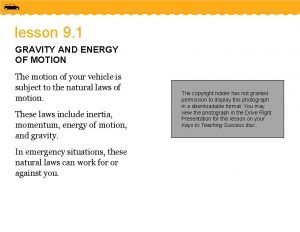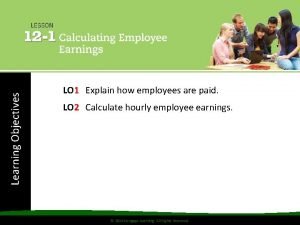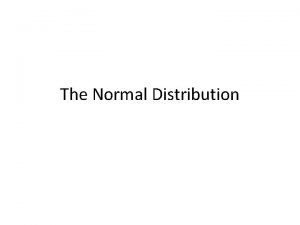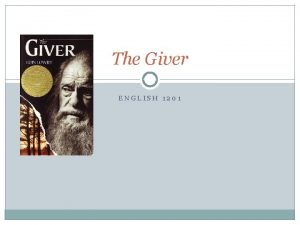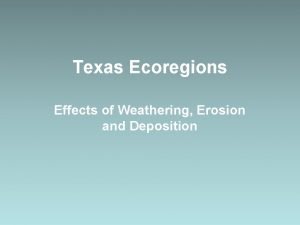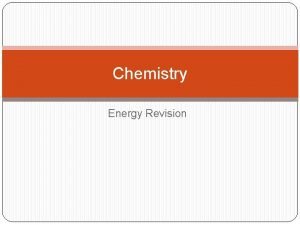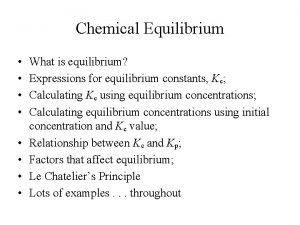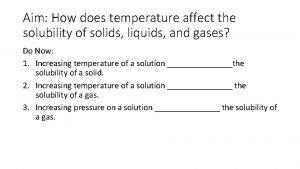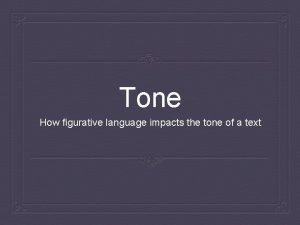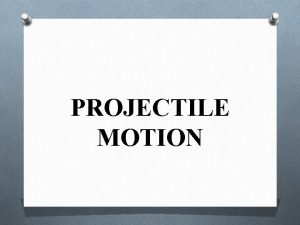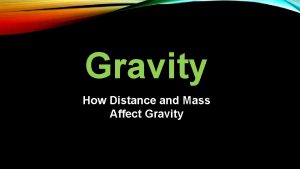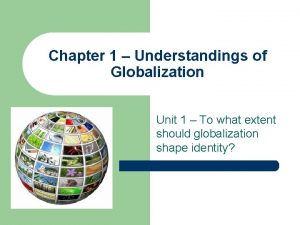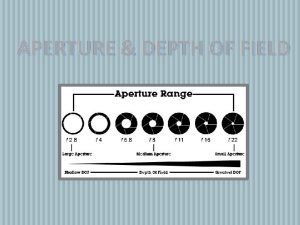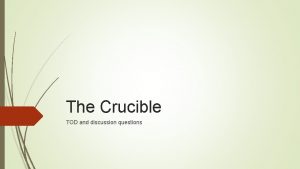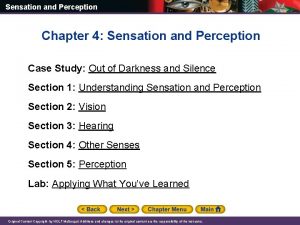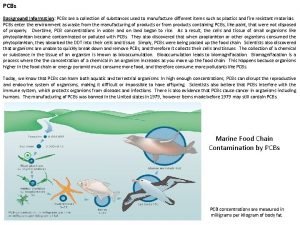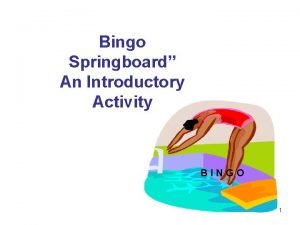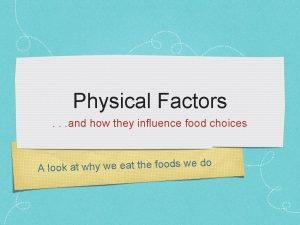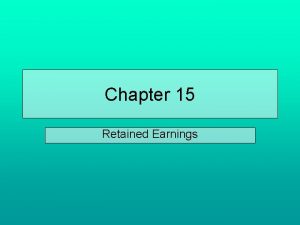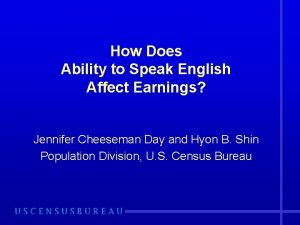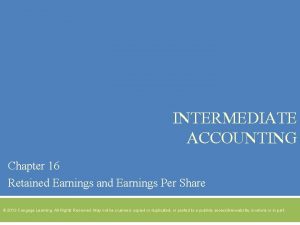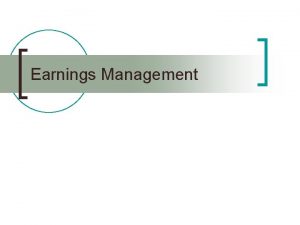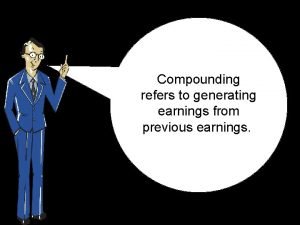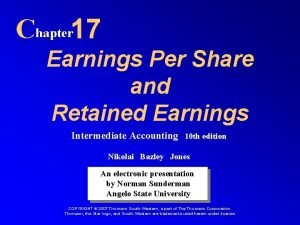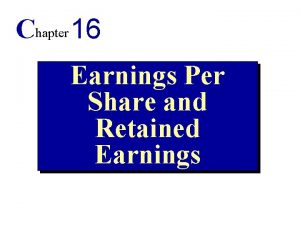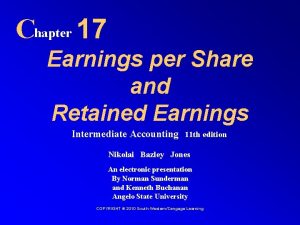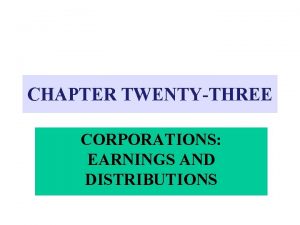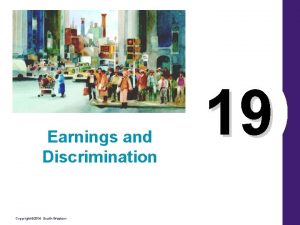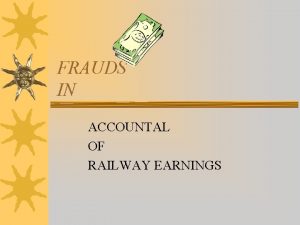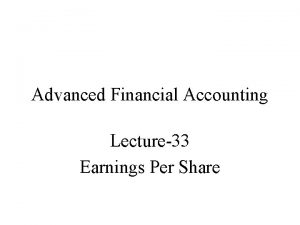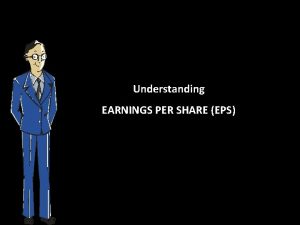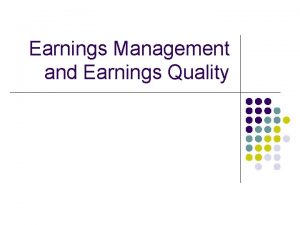How Does Your Kindergarten Classroom Affect Your Earnings






























































- Slides: 62

How Does Your Kindergarten Classroom Affect Your Earnings? Evidence from Project STAR Raj Chetty, Harvard John N. Friedman, Harvard Nathaniel Hilger, Harvard Emmanuel Saez, UC Berkeley Diane Schanzenbach, Northwestern Danny Yagan, Harvard May 2011

Introduction What are the long-term impacts of early childhood education? Limited evidence because few datasets link information on childhood education with adult outcomes We link data from the STAR experiment to U. S. tax records to analyze how class assignment in grades K-3 affects adult outcomes

Project STAR Background Student/Teacher Achievement Ratio (STAR) experiment: Conducted from 1985 to 1989 in Tennessee One cohort of 11, 571 children in grades K-3 at 79 schools Most children born in 1979 -80 graduate high school in 1998 Students and teachers randomized into classrooms within schools Class size differs: small (15 students) or large (22 students) Classes also differ in teachers and peers Randomized into classroom upon entry into participating school and kept in small/large track from grades K-3 Only one cohort treated no repeat teacher observations

Project STAR Background Large literature on STAR shows that class size, teacher quality, and peer quality have causal impacts on scores Students in small classes have 5 percentile point (0. 2 sd) higher test scores in K-3 (Krueger 1999) But test score gains fade out to 1 -2 percentiles by grade 8 Similar fade out effects observed in other early childhood interventions (e. g. Currie and Thomas 1995, Deming 2009) Do early test score gains translate into impacts on adult outcomes?

United States Tax Dataset covers full U. S. population from 1996 -2008 Approximately 90% of working age adults file tax returns Third-party reports yield data on many outcomes even for non-filers Employer and wage earnings from W-2 forms College attendance from 1098 -T forms 95% of STAR records were linked to tax data

Table 1: Summary Statistics STAR Sample (1) U. S. 1979 -80 cohort (2) Mean Wage Earnings (2005 -07) $15, 912 $20, 500 Zero Wage Earnings (2005 -07) 13. 9% 15. 6% Attended College in 2000 (age 20) 26. 4% 34. 7% Attended College by age 27 45. 5% 57. 1% $48, 010 $65, 660 Mean Parents’ Income (1996 -98)

Outline 1. Test scores and adult outcomes in the cross-section 2. Impacts of observable classroom characteristics 3. Impacts of unobservable classroom characteristics 4. Fade-out, re-emergence, and non-cognitive skills 5. Cost-benefit analysis

Part 1: Cross-Sectional Correlations Begin by correlating KG test scores with adult outcomes Useful to benchmark estimates from randomized interventions Estimate both raw correlations and OLS regressions with controls: - quartic in parental household income interacted with marital status - mother age at child’s birth - parent’s 401 K contributions, home ownership - child’s gender, free lunch status, race, and age Test score: percentile score on Kindergarten Stanford Achievement Test (math + reading)

What is a kindergarten test? Instructions: I’ll say a word to you. Listen for the ending sound. You circle the picture that starts with the same sound. “cup”

Figure 1 a: Wage Earnings vs. KG Test Score Mean Wage Earnings from Age 25 -27 $25 K $20 K $15 K R² = 0. 05 $10 K 0 20 40 60 KG Test Score Percentile 80 100

Test Scores and Earnings in the Cross-Section Dependent Var. : KG Test Percentile Wage Earnings (1) (2) (3) (4) $132 ($12. 2) $93. 8 ($11. 6) $90. 0 ($8. 65) $97. 7 ($8. 47) $146 ($8. 15) Parental Income Percentile Entry Grade KG KG All Class Fixed Effects x x x Student Controls x x x Parent Controls x x Adjusted R 2 0. 05 0. 17 0. 16 Observations 5, 621 9, 939

Figure 1 b: College Attendance Rates vs. KG Test Score Attended College before Age 27 80% 60% 40% 20% 0% 0 20 40 60 KG Test Score Percentile 80 100

An Earnings-Based Index of College Quality We construct an index of college quality using tax data Tuition paid to any higher ed. institution (Title IV) automatically generates a 1098 -T form linking student and institution Calculate average wage earnings (from W-2 s) by college For those who do not attend college, define college quality index as mean earnings for those not in college in 1999

An Earnings-Based Index of College Quality US News Ranking 1 2 3 4 5 6 7 8 9 10 …. 121 122 123 124 125 College Mean Earnings at age 28 Harvard Princeton Yale Cal Tech MIT $79, 643 Stanford U Penn Columbia U Chicago Duke $75, 570 Arizona St. Catholic U MI Tech U Buffalo U San Fran $46, 390

College Quality vs. KG Test Score Earnings-Based College Quality Index $28 K $26 K $24 K $22 K $20 K $18 K 0 20 40 60 KG Test Score Percentile 80 100

Owned a Home by Age 27 Home Ownership vs. KG Test Score 40% 30% 20% 0 20 40 60 KG Test Score Percentile 80 100

Retirement Savings vs. KG Test Score Made a 401(k) Contribution by Age 27 45% 40% 35% 30% 25% 20% 0 20 40 60 KG Test Score Percentile 80 100

Marriage by Age 27 vs. KG Test Score 55% Married by Age 27 50% 45% 40% 35% 30% 25% 0 20 40 60 KG Test Score Percentile 80 100

Lived Outside TN before Age 27 Cross-State Mobility vs. KG Test Score 35% 30% 25% 20% 0 20 40 60 KG Test Score Percentile 80 100

Percent College Graduates in ZIP code vs. KG Test Score Percent College Graduates in 2008 ZIP 22% 20% 18% 16% 14% 0 20 40 60 KG Test Score Percentile 80 100

Part 2: Validity of the STAR Experimental Design Validity of experimental analysis rests on two assumptions: Assumption 1: Randomization All pre-determined variables (e. g. parent characteristics) are balanced across classrooms Assumption 2: No Differential Attrition 95% match rate little attrition here No evidence of differences in match rates across classrooms No evidence of differences in death rates across classrooms

Part 3: Class Size Impacts Regress outcomes on dummy for small class assignment (intent to treat) with school fixed effects Analyze impacts on four outcomes: 1. College attendance 2. College quality index 3. Mean earnings (ages 25 -27) 4. Standardized (SD = 1) summary index of other outcomes: Index = 401 K + Home Owner + Married + Moved out of TN + Pct. College Grads. in Zip

Figure 2 a: Effect of Class Size on College Attendance by Year Percent Attending College 30% 25% 20% 15% 10% 2000 2002 2004 Year Large Class Small Class 2006

Frequency Figure 2 b: College Earnings Quality by Class Size $20 K $30 K $40 K $50 K Earnings-Based Index of College Quality Large Class Small Class

Figure 2 c: Effect of Class Size on Wage Earnings by Year $18 K $16 K Wage Earnings $14 K $12 K $10 K $8 K $6 K 2000 2002 2004 Year Large Class Small Class 2006

Table 5: Impacts of Class Size on Adult Outcomes Dependent College In 2000 Var. : (1) College Quality Wage Earnings (2) (3) Summary Index (4) Small Class 2. 02% (1. 10%) $119 ($97) $4 ($327) 5. 06% (2. 16%) Observations 10, 992 Mean of Dep. Var. 26. 4% $27, 115 $15, 912 0. 00 Note: All specifications control for school-by-entry-grade effects.

Part 3: Teacher/Peer Effects Students randomly assigned to classes that differ in teacher and peer quality Do teachers/peers affect adult outcomes? First test: does random assignment to a more experienced KG teacher improve adult outcomes? Not necessarily causal effect of raising teacher experience per se Experienced teachers may also differ on other dimensions such as dedication to teaching

Figure 3 a: Effect of Teacher Experience on Test Scores KG Test Score Percentile 56 54 52 50 48 0 5 10 15 Kindergarten Teacher Experience (Years) 20

Figure 3 b: Effect of Teacher Experience on Earnings Mean Wage Earnings, 2005 -2007 $19 K $18 K $17 K $16 K 0 5 10 15 Kindergarten Teacher Experience (Years) 20

Figure 3 c: Effect of Teacher Experience on Earnings by Year $20 K $1104 $18 K Wage Earnings $16 K $14 K $12 K $10 K $8 K 2000 2002 2004 2006 Year Teacher Experience <=10 Years Teacher Experience > 10 Years

Table 6: Observable Teacher vs. Peer Effects Dependent Var. : Test Score (1) (2) Teacher with >10 Years Experience 3. 18% (1. 26%) $1093 ($546) Teacher has post-BA deg. -0. 85% (1. 15%) -$261 ($449) Wage Earnings (3) % Black Classmates -$1, 757 ($2, 692) % Female Classmates -$67. 5 ($1, 539) % Free-Lunch Classmates -$285 ($1, 731) Classmates’ Mean Age -$25. 8 ($1, 359) Classmates’ Mean Pred. Score (4) -$23. 3 ($93. 7) Entry Grade KG KG All Observations 5, 601 6, 005 10, 992 Note: All specifications control for school fixed effects and class size, as well as student and parent demographics.

Part 4: Unobservable Class Effects Many elements of teacher and peer quality (e. g. clarity of instruction, enthusiasm) are not observable Well known problem in literature on teacher effects Test for “class effects” on adult outcomes using analysis of variance Is there significant intra-class correlation in student’s outcomes? This class effect includes effect of teachers, peers, and any class-level shocks such as noise outside classroom Formally, we are testing for clustering of outcomes by (randomly assigned) classroom

A Model of Class Effects Test scores and earnings for individual i in class c: zc = class-level intervention (e. g. better teaching) that affects scores and earnings z. Yc = intervention that affects earnings but not scores

A Model of Class Effects Test scores and earnings for individual i in class c: zc = class-level intervention (e. g. better teaching) that affects scores and earnings z. Yc = intervention that affects earnings but not scores aic = academic ability nic = earnings ability orthogonal to academic ability

A Model of Class Effects Test scores and earnings for individual i in class c: zc = class-level intervention (e. g. better teaching) that affects scores and earnings z. Yc = intervention that affects earnings but not scores aic = academic ability nic = earnings ability orthogonal to academic ability b + g = impacts of interventions on earnings b = covariance of class effects on scores and earnings

A Model of Class Effects Test scores and earnings for individual i in class c: Thus far, we have estimated b directly by using observable z’s that affect test scores (e. g. teacher experience) How can we estimate b and g when class-level interventions are unobserved?

Strategy 1: Analysis of Variance Test for class effects on earnings (b + g > 0) using ANOVA Do earnings vary across classes by more than what would be predicted by random variation in student abilities? Two steps: [Fixed effects] Test for significance of class fixed effects [Random effects] Estimate class-level SD of outcomes assuming normally distributed class effects

Table 7: Analysis of Variance: Kindergarten Class Effects Dependent Var. : Grade K Scores 8 Scores (1) (2) Wage Earnings (3) (4) (5) (6) P-value of F-Test on KG Class Fixed Effects 0. 000 0. 419 0. 047 0. 026 0. 020 0. 042 SD of Class Effects (RE estimate) 8. 77% 0. 000% $1, 497 $1, 520 $1, 703 $1, 454 x x x Demographic Controls Large Classes Only x Observable Class Chars. Observations x 5, 621 4, 448 6, 025 Note: All specifications control for school fixed effects and class size. 4, 208 5, 983

Strategy 2: Covariance of Class Effects on Scores and Earnings ANOVA does not tell us whether class effects on scores are correlated with class effects on earnings (b > 0) Do class-level interventions that raise test scores also improve adult outcomes? Turn to a second strategy to measure covariance between class effects on scores and earnings (b ) What is the correlation of class effects on scores and class effects on earnings? Derive estimator for b and prove it is unbiased in paper; give a heuristic explanation here

Peer-Score Measure of Class Quality Average end-of-year test scores in class relative to school sc is a (noisy) measure of class effect on scores: Motivates regression of the form: Own-observation bias: with finite class size, Eb. M > 0 even if b. M = 0 Smart kid raises average class score and has high earnings Analogous to bias in 2 SLS estimate with weak instruments Use jackknife (leave-out mean) to measure class effect on scores: sc-i

Peer-Score Measure of Class Quality Regression specification: This regression does not estimate peer effects because we are using end-of-year test scores Class quality sc-i captures teacher quality + class-level shocks Good teachers raise peers’ end of year scores Class quality sc-i varies randomly within schools Can test whether classes that generate test score gains also generate earnings gains

Peer-Score Measure of Class Quality Regression specification: Three remaining sources of bias in b. LM 1. Mechanical: Peers below-avg. you are above avg. (Guryan, Kroft, Notowidigdo 2009). Solution: define intercept using leave-out mean 2. Attenuation: sc-i is a noisy measure of class quality 3. Reflection: with peer effects, smart kid raises peers’ scores and earns a lot, driving up b. LM After presenting results, we bound reflection bias and show it is

Figure 4 a: Effect of Early Childhood Class Quality on Own Score 70 Own Test Score Percentile 65 60 55 50 45 40 -20 -10 0 10 Class Quality (End-of-Year Peer Scores) 20

Figure 4 c: Effect of Early Childhood Class Quality on Earnings Mean Wage Earnings, 2005 -2007 $17. 0 K $16. 5 K $16. 0 K $15. 5 K $15. 0 K $14. 5 K -20 -10 0 10 Class Quality (End-of-Year Peer Scores) 20

Figure 5 a: Effect of Class Quality on Earnings by Year $18 K $875 Wage Earnings $16 K $14 K $12 K $10 K $8 K 2000 2002 Below-Average Class Quality Year 2004 2006 Above-Average Class Quality

Table 8 a: Impacts of Class Quality on Earnings Dependent Variable: Class Quality (peer scores) Entry Grade Wage Earnings ($) (1) (2) (3) (4) 50. 61 (17. 45) 61. 31 (20. 21) 53. 44 (24. 84) 47. 70 (18. 63) All KG Grade ≥ 1 Observable class chars. x Observations 10, 959 10, 859 6, 025 4, 934 NOTE--All regressions control for student and parent demographics and school-by-entry-grade fixed effects.

Table 8 b: Impacts of Class Quality on Other Adult Outcomes Dependent Variable: College in 2000 College by Age 27 College Quality Summary Index (%) ($) (%) (1) (2) (3) (4) Class Quality (peer scores) 0. 096 (0. 046) 0. 108 (0. 053) 9. 328 (4. 573) 0. 250 (0. 098) Observations 10, 959 NOTE--All regressions control for student and parent demographics and school-by-entry-grade fixed effects.

Bounding Reflection Bias Small impact of KG class quality on subsequent test scores places a tight upper bound on reflection bias Smart kids score high on all tests (test scores highly autocorrelated) To have large reflection bias, smart kid must raise peer scores a lot Large correlation between peer scores and own score in later grades We formalize this intuition in a linear-in-means model and derive a bound on the degree of reflection bias Observed correlation between KG peer scores and 8 th grade score places an upper bound on reflection bias of 20% Variance in scores implies attenuation bias of 20% as well

Figure 6 a: Fadeout of Class Effect of 1 SD of Class Quality on Test Scores by Grade 10 Test Score Percentile 8 6 4 2 0 0 2 4 6 8 Grade 1 SD Class Quality Effect on Test Scores 95% CI E

Figure 6 b: Fadeout of Class Effect of 1 SD of Class Quality on Earnings $1000 Wage Earnings $800 $600 $400 $200 $0 0 2 4 6 8 Grade 1 SD Class Quality Effect on Wage Earnings 95% CI E

Fade-out and Re-emergence: The Role of Non-Cognitive Skills Why do effects of kindergarten class fade out and re-emerge? One explanation: non-cognitive skills (Heckman 2000) Data on non-cognitive measures (effort, initiative, disruption) collected for random subset of STAR students in 4 th and 8 th grade Please consider the behavior of Jim Smith over the last 2 -3 months. Circle the number that indicates how often the child exhibits the behavior. #1. Acts restless, is often unable to sit still #2. Annoys or interferes with peers’ work Some. Never times Always 1 2 3 4 5 Convert mean non-cog score to percentile scale as above

Mean Wage Earnings vs. Grade 4 Non-Cognitive Percentile Mean Wages Earnings, 2005 -2007 $25 K $20 K $15 K $10 K 0 20 40 60 Grade 4 Non-Cognitive Percentile 80 100

Table 9: Wages Earnings, Class Quality and Non-Cognitive Skills Grade 8 Dependent Variable: Wage Earnings Math+ Read (1) (2) Grade 4 Scores Grade 8 Scores Math+ Non. Read Cognitive (3) Grade 4 Non-Cog. Score $87. 7 ($20. 4) 0. 059 (0. 017) Grade 4 Math + Reading Score $36. 4 ($24. 7) 0. 671 (0. 023) (4) 1, 360 Observations 1, 254 4, 023 (5) (6) 0. 047 0. 153 (0. 035) (0. 065) Class Quality (peer scores) 1, 671 0. 064 0. 128 (0. 041) (0. 054) 4, 448 1, 780

Fade-out and Re-emergence: The Role of Non-Cognitive Skills Non-cognitive skills provide a simple explanation of our findings High quality KG teachers raise KG test scores partly through good classroom management Good classroom management instills social skills Social skills not directly measured in standardized tests but have returns in the labor market Rapid fadeout in math and reading tests after KG But significant earnings gains from better KG class

Part 6: Cost-Benefit Analysis Assume: 3% real discount rate, constant percent income gains, income follows average US income profile, constant effects of class quality 1. One SD increase in KG class quality for a single year Total NPV earnings gain for class of 20 students of $782 K 2. 33% reduction in class size $4 K-$189 K per class (very imprecisely estimated) 3. One SD improvement in teacher quality $170 -$214 K per class Moving from below-avg (25 th pctile) to above-avg (75 th pctile)

School Quality and Income Inequality Intergenerational income correlation of around 0. 3 (Solon 1999) How much of this can be explained by the fact that higher income families have access to better public schools? In STAR data, each $10 K of parents’ income increases class quality in each grade by 0. 7% of a SD Use our estimates of effect of class quality on child’s earnings and assume constant class-quality effects across grades Roughly 1/3 of intergenerational income transmission runs through differences in school quality in K-12

Part 2: Validity of the STAR Experiment Design Threat #1: Failure of Randomization Prior studies had few baseline measures, limiting ability to evaluate randomization protocol (Schanzenbach 2006) We test for balance across class types with an expanded set of parent/sibling characteristics in two ways: 1. Do characteristics vary across small vs. large class types? 2. Do characteristics vary across classrooms within schools?

Table 2: Randomization Tests Dependent Variable: Wage Earnings (%) (1) 65. 47 Parent’s Income (6. 634) ($1, 000 s) [9. 87] Small Class (%) (2) -0. 003 (0. 015) [-0. 231] Teacher Exp. Class Effects (%) p-value (3) (4) -0. 001 0. 848 (0. 002) [-0. 509] Mother’s Age at STAR Birth 53. 96 (24. 95) [2. 162] 0. 029 (0. 076) [0. 384] 0. 022 (0. 012) [1. 863] 0. 654 Parents Have 401(k) 2273 (348. 3) [6. 526] 1. 455 (1. 063) [1. 368] 0. 111 (0. 146) [0. 761] 0. 501 Student Female -2317 (425. 0) [-5. 451] -0. 226 (0. 864) [-0. 261] 0. 236 (0. 111) [2. 129] 0. 502 Student Black -620. 8 (492. 0) [-1. 262] 0. 204 (1. 449) [0. 141] 0. 432 (0. 207) [2. 089] 0. 995 p-Value of F Test 0. 000 0. 261 0. 190 Observations 10, 992 10, 914 Note: Regressions include school-by-entry-grade fixed effects.

Validity of the STAR Experiment Design Threat #2: Selective Attrition Much less attrition than in prior studies of STAR because we follow 95% of the sample Test for selective attrition through two channels: 1. Does match rate vary across treatment groups? 2. Does death rate vary across treatment groups (Muennig et al. 2010)?

Table 3: Tests for Selective Attrition Dependent Variable: Matched Small Class p Value on F test on Class Effects Deceased (%) (1) (2) -0. 019 (0. 467) 0. 951 Demographic Controls (%) (3) (4) 0. 079 (0. 407) -0. 010 (0. 286) -0. 006 (0. 286) 0. 888 0. 382 x Mean of dep. Var. Observations x 95. 0 1. 70 11, 571 10, 992

Correlation between Earnings at Age and Age + 6 Appendix Table 1: Correlation of Earnings Over the Life Cycle. 8 . 6 . 4 . 2 0 20 30 40 Age 50

Table 6: Observable Teacher vs. Peer Effects Dependent Var. : Test Score (1) Wage Test Score Earnings (2) (3) Wage Earnings (4) Teacher with >10 Years Experience 3. 18% (1. 26%) $1093 ($546) 1. 61% (1. 21%) -$536 ($619) Teacher has post-BA deg. -0. 85% (1. 15%) -$261 ($449) 0. 95% (0. 90%) -$359 ($500) (5) % Black Classmates -$1, 757 ($2, 692) % Female Classmates -$67. 5 ($1, 539) % Free-Lunch Classmates -$285 ($1, 731) Classmates’ Mean Age -$25. 8 ($1, 359) Classmates’ Mean Pred. Score (6) -$23. 3 ($93. 7) Entry Grade KG KG Observations 5, 601 6, 005 Grade ≥ 1 4, 270 4, 909 All 10, 992 Note: All specifications control for school fixed effects and class size, as well as student and parent demographics.
 How does inertia affect your vehicle and passengers
How does inertia affect your vehicle and passengers Does music affect your memory
Does music affect your memory How does threegreen calculate overtime earnings?
How does threegreen calculate overtime earnings? Sourima mal
Sourima mal Trans pecos weathering erosion and deposition
Trans pecos weathering erosion and deposition Weathering
Weathering Solute potential
Solute potential Nutrient cycle of a tropical rainforest
Nutrient cycle of a tropical rainforest Historical background of romeo and juliet
Historical background of romeo and juliet Tragic love an introduction to romeo and juliet
Tragic love an introduction to romeo and juliet How does the sun affect tides
How does the sun affect tides How does changing the mean affect a normal curve
How does changing the mean affect a normal curve Punished by his love chapter 1201
Punished by his love chapter 1201 Piney woods
Piney woods Weathering erosion and deposition in blackland prairie
Weathering erosion and deposition in blackland prairie How does lupito's death affect antonio
How does lupito's death affect antonio Does overfishing affect coral reefs
Does overfishing affect coral reefs World geography today
World geography today Force and motion in plants
Force and motion in plants How does wind affect weather and climate
How does wind affect weather and climate Current problems of filipino entrepreneurs
Current problems of filipino entrepreneurs How does pressure affect boiling point
How does pressure affect boiling point Does a catalyst affect enthalpy
Does a catalyst affect enthalpy How does temperature affect rate of reaction
How does temperature affect rate of reaction How to calculate kc
How to calculate kc How does pressure affect solubility
How does pressure affect solubility Blood vessels
Blood vessels How does temperature affect ksp
How does temperature affect ksp How does temperature affect rate of reaction
How does temperature affect rate of reaction How does pressure affect solubility
How does pressure affect solubility How does electrolytes affect the chemical equilibria
How does electrolytes affect the chemical equilibria What is tone in figurative language
What is tone in figurative language What does lacemops mean
What does lacemops mean What are two components of projectile motion
What are two components of projectile motion How does location affect trade
How does location affect trade How does distance affect gravity
How does distance affect gravity Does music affect heart rate
Does music affect heart rate Description of globalization
Description of globalization How does silica affect lava
How does silica affect lava How does aperture affect depth of field
How does aperture affect depth of field How does rodriguez use of repetition affect the tone
How does rodriguez use of repetition affect the tone Discussion questions for the crucible act 1
Discussion questions for the crucible act 1 How does heat affect viscosity
How does heat affect viscosity How does the law of continuity affect stroboscopic motion?
How does the law of continuity affect stroboscopic motion? How does water purity affect surface tension hypothesis
How does water purity affect surface tension hypothesis Biomagnifacation
Biomagnifacation Does the weight of a paper airplane affect the distance
Does the weight of a paper airplane affect the distance Radiographic film
Radiographic film How does the weather affect us
How does the weather affect us How does climate change affect us
How does climate change affect us What is considered northwestern europe
What is considered northwestern europe Risk assessment
Risk assessment Chapter 3 the pearl
Chapter 3 the pearl Consumer surplus in monopolistic competition
Consumer surplus in monopolistic competition How does literacy rate affect the standard of living
How does literacy rate affect the standard of living How does distance affect diffusion
How does distance affect diffusion What is optimum weight
What is optimum weight Explain how job choices affect income
Explain how job choices affect income A narrow field of vision (140 degrees or less) is called...
A narrow field of vision (140 degrees or less) is called... How can your digital footprint affect you in the future
How can your digital footprint affect you in the future Describe factors that affect your potential earning power
Describe factors that affect your potential earning power Interview warm up
Interview warm up Factors that affect your food choices
Factors that affect your food choices
